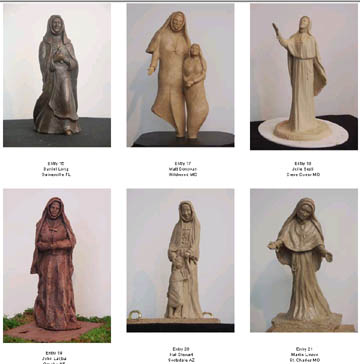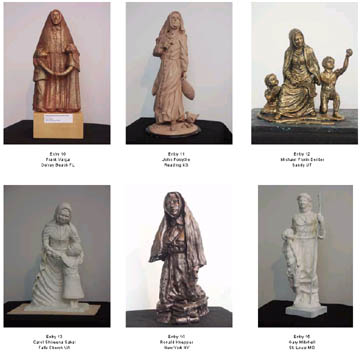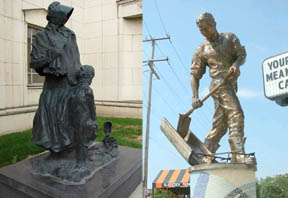In 1988, Philippine Duchesne was canonized by Pope John Paul II. She is one of only six American saints: five nuns and one bishop. An organizer of the Sisters of the Sacred Heart in France, she was granted her dream to serve as missionary in the USA in 1817. Traveling up the French Catholic Mississippi to St. Charles, Missouri, she founded the first Sacred Heart house in the USA.
At the end of her life in the 1840s, she worked with the Potawatomi people that had been forced marched from Indiana to Kansas in 1838 on the “Trail of Death”. The Potawatomi Catholics still respect her memory at the St. Mary’s Sugar Creek Mission.
When a notice of the winner of the Foundry Art Centre’s “Historic Figures in Bronze – Art in Public Places” competition arrived in my mailbox, I knew nothing of Saint Phillippine, the Potawatomi people, the “Trail of Death”, American saints or the Sisters of the Sacred Heart. Now I know. And that is good.
Map of “Trail of Death” and 2004 Potawatomi Catholics
To me, this knowledge is the goal of the interpretative film, novel, sculpture or plaque regarding the historical person or event (historic in that nobody is alive that was there.) The rumors surrounding the historic person must be alive in some group of people. Permanent artistic interpretation of the historic person reflects directly on the people that commissioned or displayed the work of art. From the point of view of the sponsors, artwork is made as a way to speak to the future about the sponsors. (The artists have different reasons.) The future can be the next day as well as the next century. Yes, even tomorrow is the future. If the value was only for moment, then permanent art would not be necessary. The action of spoken words would be sufficient.
There is another kind of recording that is not artistic. Generally, “objectivity” or “consensus opinion” is valued in the recorder’s efforts. This purpose of the recording is for efficiency. Writing or photographing or sculpting can convey the ideas about the historic person and the recorder’s attitude when the recorder is not present. Millions of people can learn through a ten-minute television broadcast or a through a hundred years of tourists passing the marker.

This confusion of the tasks of the recorder or the artist causes some of the problems with public art related to historic persons or events. The artist is frequently asked to be the recorder rather than the presenter of TODAY’S understandings. The artist is asked to make a “timeless” artwork which actually means a preconceived idea of the physical attributes of art serving the role of recorder, not art. As recorder, the artist is trapped inside the “consensus opinion” about the person or event. The larger the intended audience, the more generic the “consensus opinion”.
The competition for a sculpture regarding Philippine Duchesne suffers from this situation. All the artworks are recording the generic consensus opinion – a nun that prayed and had some positive relationship with children, especially Native American. Almost all include the crucifix and rosary beads. The flowing and/or enclosing feature of a nun’s habit is the primary formal aspect within a totem or triangular compositional format. Oversized heads, hands and crucifixes create emphasis. The body is repressed. The only unique element is a chicken and a staff.

When viewing the competition entries, I have no idea why the sponsors think this woman is special or why she is a saint. Nothing really special about praying and loving children that is practiced by a majority of human beings. None of the sculptures demonstrate any internal emotional complexity that must have existed in a lone woman from France on the American frontier helping people considered “sub-human” by many. To me, her personal resolve must have been as powerful as Mother Teresa in India.
The winner, Harry Weber, is just a generic as the next. The artists in the competition and the sponsors have developed a set of criteria that I do not understand, but I am guessing has something to do with craftsmanship and compositional interest. From my point of view, all the works are without inspiration or risk in the making or the telling. But more important, I know nothing about the sponsors and their appreciation for this woman of faith and action.
Weber’s winning entry and his 2006 winning sculpture of Daniel Boone
What has emerged in America is a series of artistic groups that do not interact with each other. We have always understood that the remaking of traditional crafts, such as quilting, have their own rules and can be appreciated on those grounds. Now we have more and more fine art groups that repeat like traditional crafts. A short list of groups might include bronze figures, bronze animals, abstract stainless steel, semi-abstract stone carvers and oil landscapes.
Even though I might be too ignorant to appreciate these works, artists and curators within the group are quite sophisticated and understand quality artistic achievement. But I have an instinct that because the realistic work is based on photography instead of self-conscious imagination, the sponsors do not consider the sophisticated curators 100% necessary. I have a feeling that the sponsors think that only a little experience is required to find the best match with a photograph that captures the generic opinion.
Even as I support a wide range of art forms displayed in the public realm and any activities that to help invent the non-geographic human diversity of the future, the sponsors of these artworks do a disfavor to all the artists and us. Without demanding that the artists convey today’s rationale for the admiration of the person or event, the workd of the figurative artists degenerate into the state of affairs that produced these competition entries without artistic purpose. It is not enough to just “honor” the historic person by a likeness and justify the expense as a public “reminder”. These are the minimum standards. Maximum standards are the goals of any artistic and cultural achievement.

Two more examples of generic concensus figurative artworks
Ever Pressing Forward, Karl A. Quilter, 2001
The International Society Daughters of Utah Pioneers pay tribute to those who made the trek in the valley of the Great Salt Lake and those who died along the way, 1847-1869. The statue is of a pioneer mother and her son.
Building the Lincoln Highway, Katheen Farrell, 2004
An early 20th century project by Carl Fischer to link NYC and San Francisco by road. (Fischer also invented the Dixie Highway linking Miami and Detroit)
Both images from the marvelous WayMarking website.
Digg it…Del.icio.us …Technorati…Stumble Upon..Reddit

From Elin Lake-Ewald
Although I agree with the writer’s view, I think that what must be taken into consideration is that the great preponderance of those who will see the sculpture are probably neither sophisticated in the appreciation of art and therefore the complexity of a more abstract rendition might not convey the meaning you speak of. It is different, for instance, with the Viet Name wall of names in Washington. That is not an abstraction, but a reality. Besides, the sculpture in Missouri repeats the familiar configurations of religious statues revered by Catholics worldwide.
Perhaps the lack of inspired sculpture by the competitors was due more to the indifference of artists asked to undertake a religious theme than to the unfortunate lack of ideas by the batch of presenters in this competition. I suspect this is the actual cause.
Weiss Responds
I don’t think I am asking for abstraction that eliminates the narrative message to people unfamilar with thinking about contemporary art. I am asking for a public narrative that is more directly related to the person being honored and her struggles and accomplishments.
You may be right regarding the lack of religious passion in the artists. Excellent point.
From Tom Durham
I agree with most of your comments, the work lacks life or emotion, and in my opinion good sculptural skill, or craftsmanship. I do not believe it is a lack of religious conviction, what it lacks is a good artistic vision. Many of the public figurative works are given to friends of relatives on the search committees or just given to the lowest bidder. Good sculpture costs money to make, The good sculptors I know turn down many of the public works because the pay is so low, often less that what it would take to cast the figure in bronze. Then when a good artist is hired they are often restricted by novice committee members, that reject any and all emotional value the artist suggests for fear of offending the general public. What they really fear is their own emotions.
Weiss Responds
Thanks for update on the panels selecting figures in bronze. Yes I noticed on the proposals in Missouri that the Mona Lisa smile dominated her face. Soft without saying anything.
In the Orthodox church, icons used to be venerated for how closely they adhered to the established canon and imitated acknowledged masters of the form, while simultaneously intensifying the desired effect of the viewer communing with the saint or figure pictured. I argue that narrative bronze sculpture today is accomplishing the same task, whether it is intended to or not. When we look at bronze figural sculpture, we (whether we know it or not) want the myth brought to life for us. We want to see Lincoln’s wart, or Washington’s nose, or the nun’s crucifix. We want to see a deer gamboling in our downtown plaza fountain so we can remember the stories of when pioneers found them gamboling in nature on the very same spot (perhaps). These are the visual equivalents of “Goodnight Moon” being read to us nightly: they are ritualistic and comforting because they do not disagree with the established fiction, cited as “reality,” on which our relationship with them is built.
And isn’t that what “civic sculpture” is all about?
At the risk of dividing the field still further, much more interesting question to me is whether or not we should push to differentiate between “civic sculpture” (or “civic art”) and “public art.” The former exalts the civitas; the latter exalts the artist. The former exists to perpetuate the common mythology; the latter seeks to promote individual expression. I would argue that both have their place and neither is superior: they just have different functions.